June 17, 2025 | 22:09 GMT +7
June 17, 2025 | 22:09 GMT +7
Hotline: 0913.378.918
June 17, 2025 | 22:09 GMT +7
Hotline: 0913.378.918
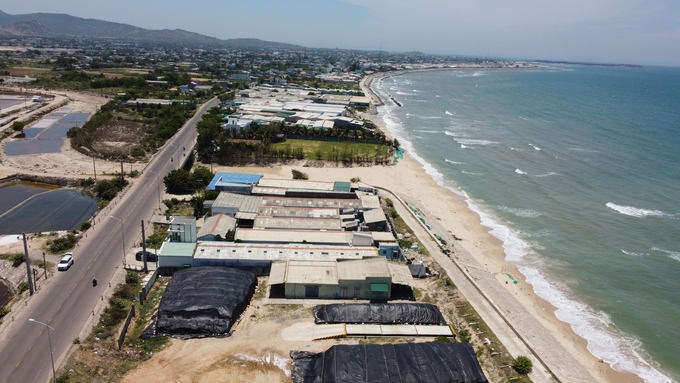
The shrimp hatchery area in Ninh Hai district, Ninh Thuan province. Photo: KS.
With its long coastline and favorable natural conditions, Ninh Thuan has many advantages for the production of brackish water shrimp seed.
According to Mrs. Nguyen Thi Le, Deputy Director of the Ninh Thuan Fisheries Sub-Department, the province currently has two areas designated for shrimp hatchery production: the An Hai high-tech aquatic seed production area (Ninh Phuoc) and the Nhon Hai concentrated aquatic seed production area (Ninh Hai), covering a total area of 298 hectares and comprising 460 facilities. These areas supply the market with 38-42 billion post larvae per year, accounting for more than 30% of the national shrimp seed production.
Specifically, the An Hai high-tech aquatic seed production area spans 168 hectares and has attracted over 130 shrimp hatchery facilities. The annual production in this area ranges from 10 to 12 billion shrimp larvae, making up 25-35% of the total shrimp seed production in the province.
The province of Ninh Thuan is currently calling for investors who meet the necessary conditions to invest in this area, with the aim of developing the An Hai hatchery area into a model high-tech shrimp seed production zone for the entire country.
Meanwhile, the Nhon Hai concentrated aquatic seed production area covers approximately 130 hectares and currently hosts over 60% of the shrimp hatcheries in the province, accounting for about 45-55% of the province's total seed production.
In addition to these two main production areas, Ninh Thuan also has several smaller regions, including Ca Na, Ninh Chu and Tri Hai, which contribute around 10% of the province's annual shrimp seed production.
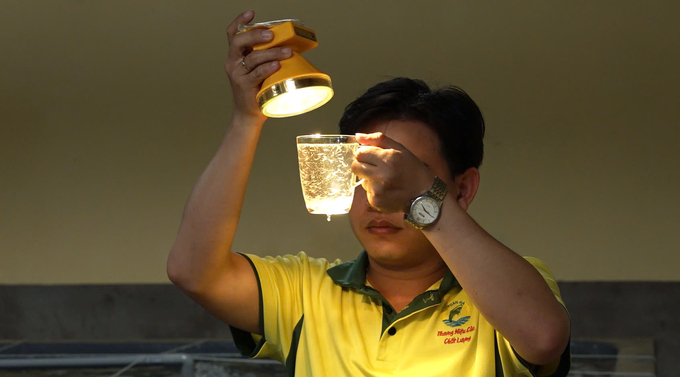
Each year, Ninh Thuan province supplies the market with 38-42 billion shrimp post larvae, accounting for over 30% of the country's total shrimp seed production. Photo: KS.
As a reputable shrimp hatchery enterprise in Ninh Thuan, Mr. Nguyen Hong Son, the Director of Newway Fisheries Investment Company, shared that the company currently supplies between 1.5 to 1.8 billion shrimp post larvae annually to the national market.
In order to ensure the delivery of high-quality shrimp seed to farmers, the company imports white-legged shrimp broodstock from the SIS Group in the United States. Each year, approximately 1,500 pairs of broodstock are brought in, which include two types of shrimp: the superior fast-growing strain and the standard fast-growing strain. These broodstock are strictly monitored by the relevant authorities in the exporting country for any potential diseases. Upon arrival in Vietnam, the broodstock undergoes a thorough quarantine and veterinary inspection process in accordance with regulations, ensuring that they are free from disease and meet the required quality standards.
Throughout the production process, the company utilizes advanced technologies to effectively manage disease control and enhance the quality of its shrimp seed. These technologies include water treatment systems that process incoming water used in production, as well as techniques for culturing live algae to provide fresh food for shrimp larvae. Additionally, the company employs technology to regulate and adjust the water temperature during the rearing of shrimp larvae, which helps to improve both the productivity and the overall quality of the shrimp larvae.
"Each broodstock lot imported costs between 75-85 USD per piece (depending on the shrimp strain). Every 4-5 days, the shrimp spawn once, with an average of about 250-350 thousand eggs. The shrimp can reproduce for 140 days according to the regulations in Circular 26/2018 of the Ministry of Agriculture and Rural Development (the old regulation). Thus, each shrimp can lay over 1 million nauplii", Mr. Son shared. He further mentioned that during the process of releasing nauplii to grow into post larvae, there is a 50% mortality rate.
It is reported that in 2024, Ninh Thuan province produced more than 44 billion shrimp post larvae, of which over 8.7 billion were black tiger shrimp and over 35 billion were white-legged shrimp. Shrimp seed from Ninh Thuan is highly valued by the domestic market for both its quality and quantity.
According to the Ninh Thuan Fisheries Sub-Department, currently, white-legged shrimp broodstock must be imported from abroad, with various sources, leading to inconsistent quality. In 2024, the Department monitored 161 lots of broodstock, consisting of 55.589 shrimp.
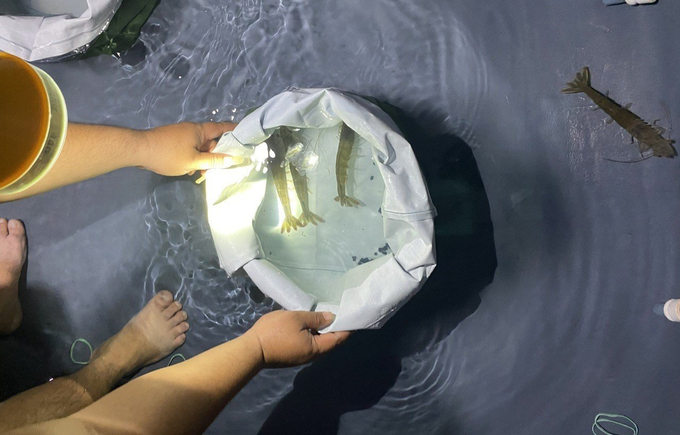
Currently, white-legged shrimp broodstock are entirely imported. Photo: KS.
Mr. Le Van Que, Chairman of the Ninh Thuan Aquatic Seed Association, mentioned that white-legged shrimp broodstock are currently imported primarily from the United States and Thailand. The advantage of these imported shrimp strains is that they have been genetically selected, which allows for better control over their growth rate. In addition, these shrimp are free from diseases and do not suffer from inbreeding, which prevents deformities and abnormalities in the larvae.
However, due to the long-distance transportation of the broodstock, there is often a loss of shrimp during transit, and the surviving shrimp tend to be weaker, leading to poor reproduction rates. In many instances, some batches of imported shrimp have had issues during the production process. However, due to the strict regulations imposed by the exporting countries, which hold a monopoly over the supply, businesses are left with little choice but to accept these risks.
"These shortcomings have affected the production of shrimp seed. When the conditions for shrimp seed production are not ideal, it inevitably impacts the quality of the seed, which directly affects the shrimp farming operations of local farmers. Therefore, it is crucial for Vietnam to take control over its own supply of broodstock. By doing so, we can improve the quality of the seed and ultimately enhance the production of farmed shrimp", Mr. Que explained.
In Ninh Thuan province, there is currently a designated disease-free shrimp broodstock production zone located in Son Hai, Thuan Nam district, covering an area of 37.7 hectares. This area is notable as it is the first and only officially planned zone for shrimp broodstock production in the entire country.
Within this zone, the Ninh Thuan Provincial People's Committee has assigned several large companies and corporations to research and develop shrimp broodstock production. Among them is the Institute of Aquaculture Research I, which has partnered with Moana Co., Ltd. to specialize in producing black tiger shrimp broodstock for breeding, with a production area of 7 hectares. Additionally, the Viet-Uc Group is constructing a dedicated center for the production of white-legged shrimp broodstock, which spans 15 hectares.
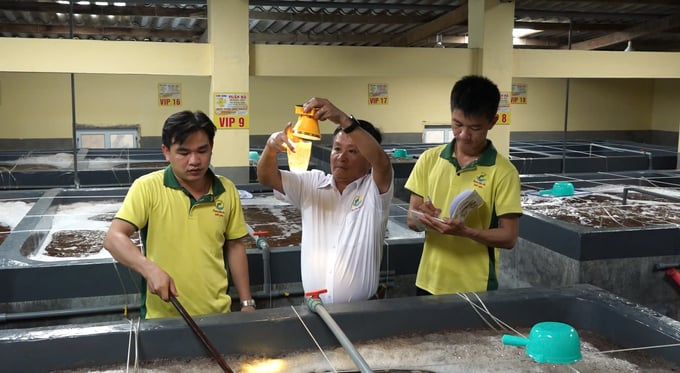
Ninh Thuan province is making efforts to improve the quality of shrimp seed. Photo: KS.
According to Mrs. Nguyen Thi Le, the Viet-Uc Group, in collaboration with the SCIRO Institute (Australia), has successfully implemented a program for enhancing white-legged shrimp broodstock. Based on the designed capacity, the annual production of white-legged shrimp broodstock at Viet-Uc Phước Dinh Co., Ltd. can reach 36,000 individuals. However, at present, the white-legged shrimp broodstock from the Viet-Uc Group primarily supplies only the company’s own hatchery systems and is not yet available for external hatcheries and seedling farming facilities.
As for black tiger shrimp broodstock, in recent years, Moana Co., Ltd. has achieved significant accomplishments in the genetic improvement and breeding of black tiger shrimp broodstock in Hawaii (USA). Annually, Moana produces between 20.000 and 30.000 black tiger shrimp broodstock, which are considered to be of high quality, disease-free, and available in sufficient quantities to supply both local and out-of-province hatcheries. Additionally, these shrimp are exported to several countries, including Taiwan, Malaysia, Nigeria, Bangladesh, Thailand and China.
According to the Ninh Thuan Fisheries Sub-Department, in order to assist shrimp farmers and regulatory authorities in easily verifying the origin of shrimp, as stipulated in Circular 26/2018 of the Ministry of Agriculture and Rural Development (dated November 15, 2018) on the management of aquatic seeds, Ninh Thuan has published a list of broodstock lots currently in the breeding period on its website. This list includes detailed information such as the importation date of the shrimp batch, the name of the production facility, the origin, the quantity of broodstock and the certification number for quarantine inspection, among other relevant details.
Translated by Phuong Linh
/2025/06/17/3942-2-143243_548.jpg)
(VAN) Recently, in Sweden, the Secretary of the Binh Dinh Provincial Party Committee presented the Investment Registration Certificate for the 'Polyester Fabric Recycling Complex' project to SYRE Impact-AB Company.
/2025/06/12/3721-2-202745_83.jpg)
(VAN) TH made an impression at Seoul Food 2025 with its line of natural beverages, paving the way for Vietnamese food products to enter the South Korean market.
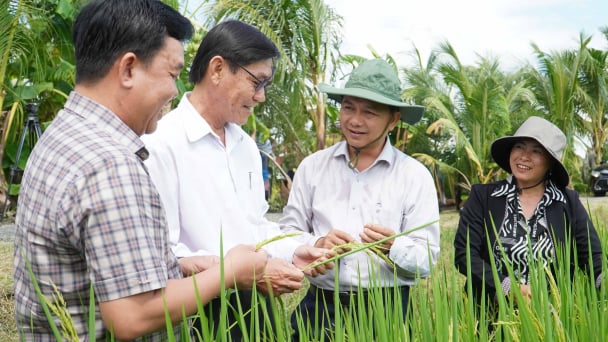
(VAN) Soc Trang's success in rice exports stems from a strategy of developing fragrant and specialty rice cultivation areas and standardizing production toward low-emission practices.
/2025/06/11/1311-5-120811_839.jpg)
(VAN) The pig farming industry is facing the challenge of comprehensive restructuring to meet requirements for quality, safety, traceability, and market expansion both domestically and for export.
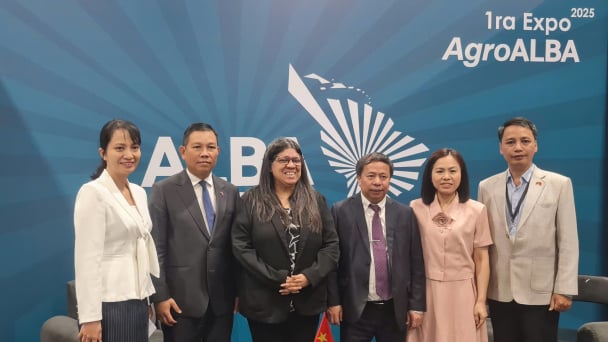
(VAN) Vietnam considers participating in ALGROALBA in order to expand agricultural production, coordinate the assessment and effective exploitation potential land.
/2025/06/05/5314-1-184727_407.jpg)
(VAN) From seemingly worthless fish scales and skin, enzymes and lactic ferments can transform by-products into peptides, opening a sustainable, effective business direction and elevating Vietnamese seafood.
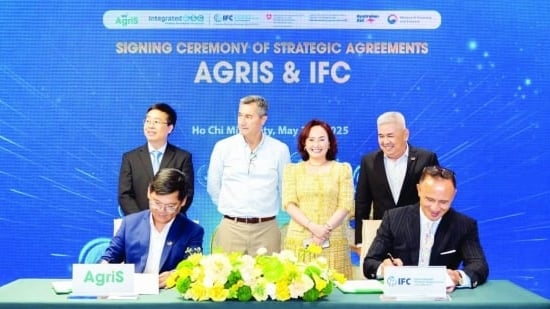
(VAN) TTC AgriS and IFC signed a strategic partnership to develop a sustainable agricultural value chain, aiming to achieve the Net Zero target by 2035.